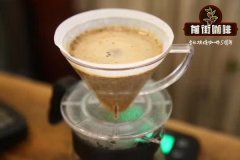[coffee marketing] opening a coffee shop can not only make coffee, but also know how to sell coffee.
Professional coffee knowledge exchange more coffee bean information please follow the coffee workshop (Wechat official account cafe_style)
In the process of learning coffee, we learned to make coffee, manage quality, digitize everything about coffee, and pursue the highest standard of ability. But often we forget that the best coffee is for people to drink and thumbs up.
Whether we are baristas or bean bakers, we all face the time when we have to provide coffee to our customers. This can happen many times in your coffee career, or even dozens, hundreds of times a day. Maintain your coffee career by selling coffee so that your coffee business can continue to grow. In particular, when you have your own customers and start your own business, how to manage it will be a subject that you must face and learn in your coffee career. Marketing management can help you manage your business, just as you use the Golden Cup Control scale to manage your cooking, baking curves, and water content / density analysis to manage your baking.
Take coffee to sell money is to do business (business), there is a business to form a market (market), there is a market will need marketing (marketing), properly manage marketing to let your market flow, in order to keep the business running. Once I chatted with an old master who had been in business for more than 20 years. The old master talked about young people learning coffee, looking for famous teachers and learning all kinds of skills, but did not learn how to sell coffee to make money. Reality could not support the ideal, so in the end, I had to walk out with a good kung fu. I believe we have all heard such stories and may have encountered them.

First of all, we need to understand what marketing is.
According to the American Marketing Institute,"Marketing is the process of analyzing, planning, executing, and controlling the conceptualization, pricing, promotion, and distribution of ideas, products, or services to create exchanges that meet individual and organizational goals."
This sentence looks like a rap sentence, but it is actually aimed at creating value, making guests satisfied, and receiving reasonable compensation. What if I changed the keyword to coffee roasting?
"Coffee roasting is a process of green bean analysis, roasting planning, replication of roasting curves, and cup testing to make decisions about roasting, flavor, brewing use, selling price, target audience, taste duration, etc., thus creating an exchange activity that meets customer tastes and store interests."
Is it easy?
You may have heard of the 4 Ps of marketing, a concept older than golden glove show (70s) and golden cup theory (60s), which was proposed in the 1950s. The 4P's are:
Product: What kind of coffee do you want to sell? Single item? Concentrated? A liter of ice American?
Price: How much does it cost? Fight Starbucks? Or is it $9.90 a cup?
Place of sale: Where to sell? Takeaway? Internet celebrity shop? Health club?
Promotion: How to promote? Wechat advertising? Hand out flyers by the roadside? Send out sample packs?
This concept was held to be the norm in the early days when commodities were at the heart of business success as long as products were made, prices were fair, the right channels were found, and marketing techniques were used. But nearly 70 years later, coffee machines can customize their transformation curves to satisfy both barista pleasure and customer taste buds. Today, we are no longer about product priority, but customer service. Like the difference between the first wave of specialty coffee and the third wave. We've gone from providing good coffee to providing a coffee experience with content. From a product-centric business model to one that communicates with customers.
In modern marketing, we focus on four key points, namely:
Creating: Providing something of value (coffee drinks or unique coffee experiences or beliefs) in a chain of suppliers and guests
Communicating: describe, or understand this valuable thing from the customer side (mutual feedback at both ends of the industry chain)
Delivery: Deliver this item to customers in a way that maximizes value (tableside service, home delivery, Meituan takeout...)
Exchange: exchange this item for an equivalent value.
The core of these four focuses is called Value. What is offered to customers, whether goods or services, we call it market offering.
Value
Value can be interpreted as the buyer receiving benefits that meet demand. Spoken English, we can say it is a kind of "cost performance," or CP value. Although the product and service are defined by the seller, the CP value is evaluated by the buyer. We can never estimate how satisfied our customers are and how cost-effective they are. Even so, after drinking my coffee, blowing my air conditioner, and peeing, you have to pay for it. The price charged by the store will affect the CP value. We can grasp the evaluation formula of personal value:
Value = Benefit Received-[Price + Hassle]
Hassle refers to how much time and effort consumers spend on the process of consumption. For example, a shop opened on a road that cars cannot pass through, and it takes half an hour to ride up a steep slope to reach it. And order coffee to listen to the boss nagging for half an hour before drinking coffee. This kind of difficulty is much more difficult than walking to the subway station for five minutes and getting a cup for five minutes. Assuming that the price is the same, consumers feel the same after drinking, the former uses the personal value formula to calculate the value is relatively low.
And the value will vary from person to person, even if it is the same commodity, different people will have different feelings. After all, consumers are not professional judges and do not receive sensory training in advanced training courses before going to coffee shops, so each consumer believes that the benefits obtained from consumption will vary. Under the condition of the same price and the same acquisition difficulty, the recognized value will be different. Today's coffee market is a value-oriented market, so consumer satisfaction will be particularly important, when consumer satisfaction can not be improved, it is difficult to get enough profit on the price.
Many baristas or roasters complain that the timing is not right. If the market was still producer-oriented before the 1920s, as long as the cost was properly controlled and the quality of the product was stable, there would be a place in the market. The barista at that time might say that good coffee does not need publicity. But this kind of manufacturing thinking with manufacturing products as the core is difficult to survive in the current market with fierce competition and numerous homogeneous commodities.
Between 1920 and the end of World War II, the world was facing a recession, and consumers were not in the mood to spend. Therefore, business experts jumped out and used words to make their products stand out in this business-oriented market. Although these business skills are out of date and old-fashioned, many people still use them today.
Half a century after World War II, the market entered a period of vigorous development, product innovation, so that consumers can understand the advantages of each product. The traditional marketing 4P also began to develop at this time, this era of baristas, in addition to making unique flavor of fine coffee, but also learn pricing, store management, and promotion strategies, such as advertising in X degree a treasure, in order to succeed in this marketing-oriented market.
Now, we are in a value-oriented market where the chips are all in the hands of consumers, and customer service and customer perception have become the key to creating value. Sometimes, not only do we have to let customers drink good coffee, but we also have to prove that we are working hard for the sustainability of the coffee supply chain. Every penny that customers pay not only allows us to continue to operate and provide premium coffee, but also allows us to do good things and let the children of the origin practice.
Although the market with the development of history and technology, in different periods have different fashion and practice. But depending on the organization and the customer base, sometimes the old methods work.
MARKET SUPPLY OFFER
The word market offering is not hard to understand. When you walk into a coffee shop, order an iced American, find a comfortable chair, plug in your laptop, watch Korean dramas on the in-store Internet, blow on the air conditioning all afternoon, and finally pay 30 bucks for the coffee shop. Product + service + price is what the coffee shop offers you in the market. These three things are often tied together and cannot be replaced by others, just as we cannot go into a coffee shop and order ice American, but enjoy the service of car washing and coating, and pay the price of a scallion cake shop. For store owners, creating valuable market supply can gain customer recognition and then get equal benefits.
Once you define your offering, the next step is to let the customer know what you're selling. Communicating is a way to convey information, and it is two-way, not only to let your customers know your offering, but also to understand customer preferences, feelings... Communication is sometimes just letting customers know that you have something they want, sometimes it is the store that educates the customer, just like Barista introduces the customer to coffee, and guides the customer to enjoy and like the coffee. In contrast, communication also opens a window for consumers to let sellers know what customers think. There are many communication tools, such as WeChat, public comment, small red book, chatter, live broadcast... et al. Interactive, such as WeChat, can help you interact with customers, know customer ideas and immediate feedback (although often full of negative energy). If your business is big enough, Public Relations will be an important job, helping you build your image through the media.
Marketing can't just be empty talk. When you have a product, attract customers, we have to find a way to get things to customers. More importantly, deliver value to customers. Suppose you are a boutique coffee shop, how do you convey the value of "boutique coffee" to customers? A supply chain is a series of processes that deliver products to customers, possibly involving many different organizations. The supply chain behind a good cup of sun-baked sidamo will be: processing plants in southwest Ethiopia and local small farmers → exporters in Addis Ababa → importers of raw beans → roasters → bar in coffee shops. Through such layers of barriers, the right goods can be delivered to customers in the right way. Logistics plays a very important role in the management of supply chain.
You deliver your goods to the right customers in the right way. I believe that you have spent a lot of effort and cost in the middle, and of course you will want to get a relative feedback. The best reward is cash, of course, Jay Chou concert tickets may also be available. But the customer pocket money or exchange (exchange) you provide goods the most objective tool.

At this point, do you think marketing is important to you?
Marketing is important to you as long as you have valuable goods that you want to offer to others in exchange for reward. But there is so little marketers can do that they can't even make coffee. So opening a coffee shop can't just make coffee, you must make good use of all kinds of resources, show the value you want to present, and sell the coffee you want in order to achieve your goal.
END
Important Notice :
前街咖啡 FrontStreet Coffee has moved to new addredd:
FrontStreet Coffee Address: 315,Donghua East Road,GuangZhou
Tel:020 38364473
- Prev

African Coffee Fine Coffee African Coffee Origin African Coffee species
Professional coffee knowledge exchange more coffee bean information Please follow the coffee workshop (Wechat official account cafe_style) drinking coffee is like drinking red wine, will look at the manor, will see the variety. There are Cabernet Sauvignon (cabernet sauvignon), Merlot (merlot), shiraz/syrah in red wine, and Arabica and Robusta in coffee, which are subdivided below.
- Next

Starbucks, the profit king of coffee shops, reported a 6% increase in same-store sales and a 9% one-day rise in its share price.
Professional coffee knowledge exchange more coffee bean information please follow the coffee workshop (Wechat official account cafe_style) Starbucks share price magic let's take a look at the Starbucks (stock code: SBUX) chart over the past few years! It can be found that it is almost a high-level process, especially the public financial report after four sets, which has soared by about 9% at one stroke. At present, the share price is close to $100.
Related
- What documents do you need to go through to open a coffee shop? coffee shop coffee shop certificate processing process
- How to purchase Coffee beans in small Cafe how to choose a suitable supplier for domestic Coffee supply Company
- How to drink Starbucks Fragrance White Coffee? how to make Australian White Coffee? what Italian coffee beans are recommended?
- The Story of Flora Coffee: the name of Flora Coffee Bean and the implication of the Flowers on Florna Coffee
- How much does a cup of coffee cost? How much is the profit of a cup of coffee? What is the profit of the coffee shop in a year?
- Yunnan small Coffee, known as "fragrant Coffee", introduces the characteristics of Alpine Arabica Coffee producing areas in Yunnan, China
- 2023 latest Starbucks full menu price list how much is a cup of Starbucks coffee what is better to drink the most popular hot and cold drinks recommended
- Starbucks different kinds of Coffee Price list Starbucks menu 2023 Top Ten Best drinks in Starbucks
- Starbucks Spring praise Comprehensive matching Coffee Bean theme Story Packaging implication and taste description
- The cost of a cup of coffee latte American coffee cost price and selling price

